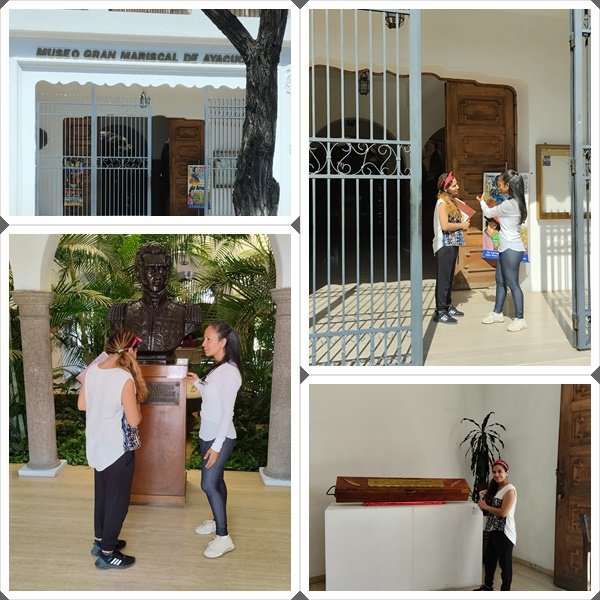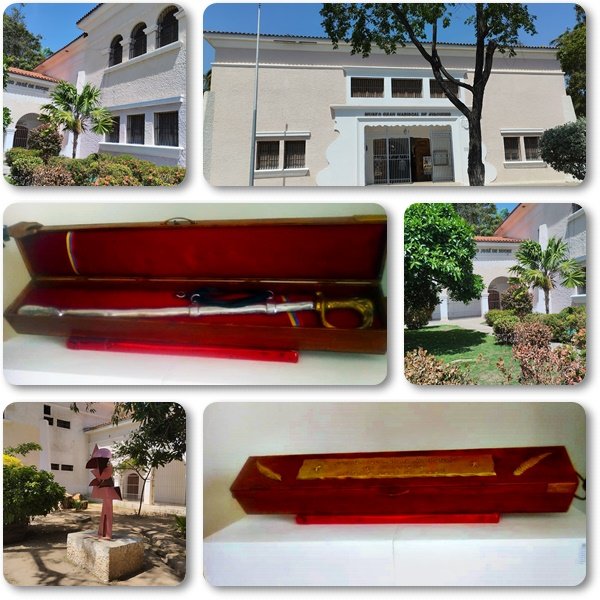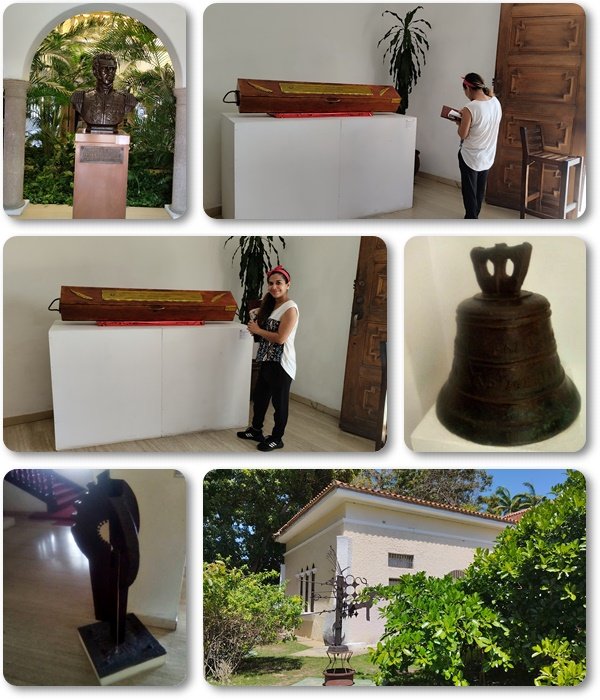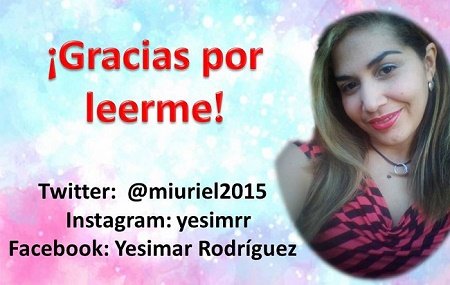
Bienvenidos a mi blog, amigos. En esta oportunidad los llevaré, a través de unas panorámicas, por una visita íntima al Museo Gran Mariscal de Ayacucho. Esta estructura cuenta con dos niveles, en este post nos centraremos en planta baja. Este icónico lugar tiene como objetivo principal destacar los aspectos más relevantes de la vida de Antonio José de Sucre, haciendo énfasis en sus proezas independentistas. Para trazar su ubicación nos centraremos en Cumaná, específicamente en la avenida Humbolt y le colocaremos de escenario trasero el río Manzanares.
Al llegar a este sitio fue recibida por el personal del museo, quiénes me dieron un recorrido por las instalaciones. Les voy a relatar la experiencia desde la entrada, el busto de bronce del Gran Mariscal nos da la bienvenida, esta estatua fue realizada por Julio César Briceño. A la derecha una réplica de la espada de este héroe independentista, elaborada en bronce y aluminio por David David, también podemos observar la campana de bronce de la iglesia Las Carmen, donde fue bautizado Sucre, a la izquierda una efigie de la virgen Santa Inés, elaborada por Orlando Zotti Delgado. Frondosas plantas y una fuente se ubican en el solar, las cuales proporcionan una vista agradable a los visitantes. En las paredes de los amplios pasillos se encuentran documentos de valor histórico como la Firma de Capitulación o el poema a Berruecos. En el pasadizo lateral hallamos la Colección de Piedra Tallada de Adulgia Sánchez, estas figurillas forman parte de las piezas invaluables del museo. En el salón contiguo hay algunas fotografías de la Cumaná de antaño.
Welcome to my blog, friends. This time I will take you, through some panoramas, on an intimate visit to the Gran Mariscal de Ayacucho Museum. This structure has two levels, in this post we will focus on the ground floor. This iconic place has as its main objective to highlight the most relevant aspects of the life of Antonio José de Sucre, emphasizing his independence feats. To trace its location we will focus on Cumaná, specifically on Humbolt avenue and we will place it as a backdrop to the Manzanares river.
When I arrived at this site I was received by the museum staff, who gave me a tour of the facilities. I will relate the experience from the entrance, the bronze bust of the Gran Mariscal welcomes us, this statue was made by Julio César Briceño. To the right a replica of the sword of this independence hero, made of bronze and aluminum by David David, we can also observe the bronze bell of the Las Carmen church, where Sucre was baptized, to the left an effigy of the virgin Santa Inés, made by Orlando Zotti Delgado. Lush plants and a fountain are located in the solar, which provide a pleasant view to visitors. On the walls of the wide corridors are documents of historical value such as the Signature of Capitulation or the poem to Berruecos. In the side passage we find the Collection of Carved Stone by Adulgia Sánchez, these figurines are part of the invaluable pieces of the museum. In the adjoining room there are some photographs of the Cumaná of yesteryear.

En este espacio también situamos la oficina administrativa y la sala Mariana Carcelén, en honor a la esposa de Sucre, un sitio destinado a la exposición de obras artísticas, en ese momento estaba la exhibición de Luis Pedro Malavé, un artista que se enfoca en el arte ingenuo o empírico, en dichas pinturas observamos diferentes tonos de verde que le confieren vida al paisaje, también rinde tributo a sus mascotas. Si avanzamos un poco más hallamos una sala de conferencias, donde se realizan diferentes actividades.
Como antesala a las escaleras nos encontramos con pinturas de Cleto Rojas, Jesús Mendoza, Rafael Parrela y Jonny Salazar, obras hermosas que decoran las paredes. Igualmente, podemos apreciar algunas lienzografías. En este punto es importante mencionar que el museo tiene una política muy estricta con respecto a la toma de fotografías, ya que se busca preservar la integridad de las obras, de modo, que no haya posibilidad de plagio.
Vamos a dejar esta entrega hasta aquí, pronto les mostraré los Salones Sucre y Ayacucho, los cuales se encuentran en la parte superior. Nos leemos en los comentarios.
In this space we also find the administrative office and the Mariana Carcelén room, in honor of Sucre's wife, a site destined for the exhibition of works of art, at that time the exhibition of Luis Pedro Malavé was exhibited, an artist who focuses on naive or empirical art, in those paintings we observe different shades of green that give life to the landscape, also pays tribute to his pets. If we advance a little more we find a conference room, where different activities are carried out.
As an anteroom to the stairs we find paintings by Cleto Rojas, Jesús Mendoza, Rafael Parrela and Jonny Salazar, beautiful works that decorate the walls. Likewise, we can appreciate some lithographs. At this point it is important to mention that the museum has a very strict policy with respect to the taking of photographs, since the aim is to preserve the integrity of the works, so that there is no possibility of plagiarism.
We will leave this installment until here, soon I will show you the Sucre and Ayacucho Halls, which are located at the top. See you in the comments.


Todas las fotos utilizadas en este post son de mi propiedad, editadas con PhotoScape.
Traducido y formateado con Hive Translator por @noakmilo.
All photos used in this post are my own, edited with PhotoScape.
Translated and formatted with Hive Translator by @noakmilo.
https://leofinance.io/threads/view/ramisey/re-leothreads-21txrgehy
The rewards earned on this comment will go directly to the people ( ramisey ) sharing the post on LeoThreads,LikeTu,dBuzz.
posh
Años que no visito ese museo amiga.
Si es muy bonito. Yo tengo pendiente llevar a mis niñas.
Las obras de la parte de arriba son muy lindas.
Arriba están algunos objetos de valor de la familia Sucre. Además, de las obras de ciertos artistas. Este museo es hermoso, está muy bien conservado. Agradecida por tu visita, amiga, siempre es un gusto tenerte por aquí. Saludos.